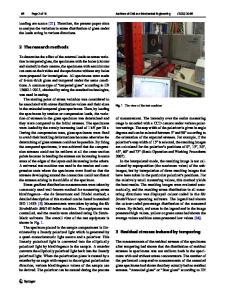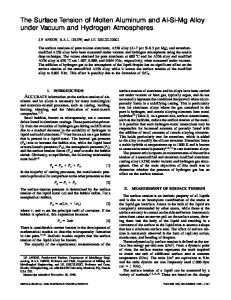Hydrogen in Crystalline Silicon under Compression and Tension
- PDF / 452,709 Bytes
- 6 Pages / 420.48 x 639 pts Page_size
- 46 Downloads / 315 Views
HYDROGEN IN CRYSTALLINE SILICON UNDER COMPRESSION AND TENSION C.S. NICHOLS and D.R. CLARKE, IBM Research Division, T. J. Watson Research Center, Yorktown Heights, NY 10598 ABSTRACT The behavior of hydrogen in crystalline silicon (c-Si) containing regions of compressive or tensile stress is important for understanding the solute's interaction with dislocations, grain boundaries, and crack tips. A series of first-principles total-energy calculations probing the stable site for hydrogen as a function of its charge state, the Fermi level position, and the crystalline lattice constant has been performed. We find that the stable site for hydrogen depends critically on both pressure and on the hydrogen charge state. Furthermore, hydrogen is predicted to undergo a transition from an interstitial site to the bond-center site as a function of pressure. INTRODUCTION Because of its ubiquitous presence, hydrogen (11) in crystalline silicon (c-Si) has been of great theoretical and experimental interest. Attention has focused primarily, although not exclusively, on the diffusion of atomic hydrogen, its molecule formation, and its complexing with and passivation of dopant impurities. A rather comprehensive understanding of hydrogen in silicon under ambient pressures has been obtained through complementary experimentall and theoretical 2 work. The behavior of hydrogen in compressional or tensional stress fields in c-Si has, however, received little systematic attention. Such information is relevant for understanding the behavior of H in Si which contains, for example, dislocations, grain boundaries, and cracks, as well as in Si devices and multilayers. We present the results of first-principles total-energy calculations exploring the behavior of H in c-Si as a function of its charge state, the Fermi level position, and the lattice constant. We examine strains for which many physical properties are expected to vary linearly although no linearity is assumed a priori. For ambient pressures, our results agree with previously reported findings for the stable charge state, minimum-energy position, and energy difference between selected locations for the H atom. 2 However, under compression and tension, we find that the energy difference between the bond-center (BC) position and the tetrahedral (T) site changes 3 rapidly, indicating a transition to a different minimum-energy position. METHODOLOGY Our calculations are based on density-functional theory, 4 within the local-density approximation, and norm-conserving pseudopotentials 5 with a plane-wave basis. A momentum-space formalism is used to solve the relevant Schrodinger equation 6 for a supercell geometry. 'Ab initio pseudopotentials, constructed according to the scheme of I lamann, Schluiter, and Chiang, 5 were used for the host Si atoms, while a Coulomb potential was used for the I I atom. Careful convergence studies have been performed with respect to supercell size, plane wave cut-off energy, and special points sampling in the irreducible wedge of the Brillouin zone. In particular
Data Loading...




